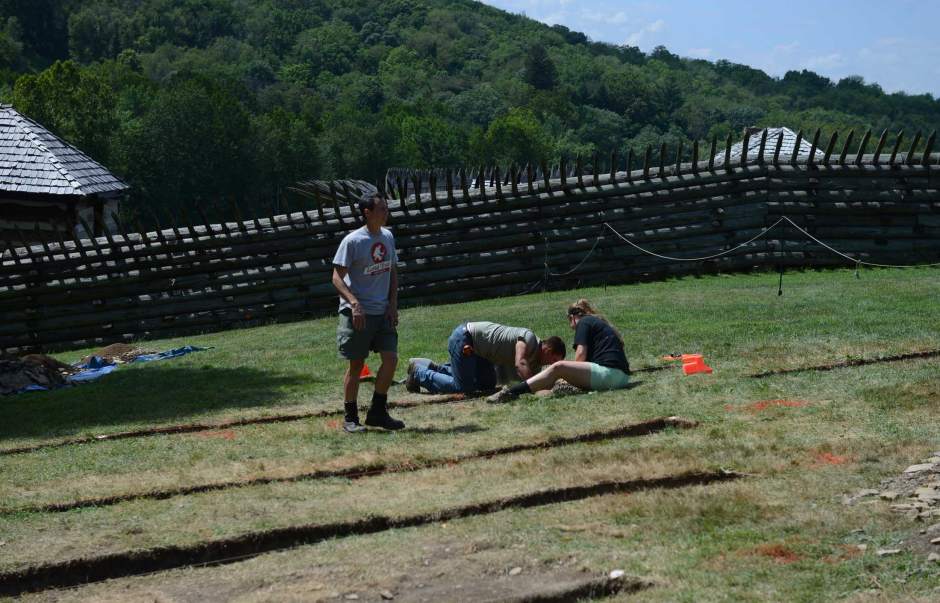https://archive.triblive.com/news/juniata-college-students-unearth-artifacts-architectural-remains-at-fort-ligonier/
Juniata College students unearth artifacts, architectural remains at Fort Ligonier

Evan Sanders | Trib Total Media
A group of Juniata College Students work on an archaeological investigation at Fort Ligonier on Tuesday, Aug. 11, 2015. The team of students and professors worked from Aug. 2-14 on the archaeological investigation at Fort Ligonier, which was the first time in almost twenty years a dig has taken place on the property.
A single historic object can be used to show and tell Fort Ligonier visitors a number of things, according to Director of History and Collections Erica Nuckles.
For instance, a horse bell can help guests imagine the noises one might have heard when gunfire broke out near a field where horses and cattle were grazing on Oct. 12, 1758.
So when a team of students uncovered an actual horse bell, covered in patina, from the upper fort grounds last week, Nuckles was thrilled.
Fort Ligonier is growing their artifacts collection and possibly the structures at the fort thanks to the labor of 10 Juniata College students who spent two weeks performing an archaeological investigation in the southeast corner of the fort's outer retrenchment. By digging and sifting through mounds of dirt, they worked to uncover relics and architectural remains from the French and Indian War, such as a line of communication and fascine artillery battery.
“It's a great opportunity for everyone involved,” Nuckles said. “It helps us learn more about our site and potentially have something to reconstruct even after all these years, and it's great to have these students and to give them the opportunity to have this hands-on experience with history.”
About 20 years have passed since the last time archaeologists searched the historic grounds, Nuckles said.
Dr. Jonathan Burns, 43, an archaeologist and teacher at Juniata College, led the field school. He has organized field schools at several other locations for six years, such as Fort Shirley in Shirleysburg. He took students to tour Fort Ligonier in the past, which led to the collaboration with its staff.
“They were like ‘Wow, if you could find some of these other features for us we would build them,' and I was like ‘Wow, I would love for my students to get great experience and find musket balls and stuff at Fort Ligonier,'” Burns said. “It's a win-win for both parties.”
“The challenge is to teach (students) all the archaeology techniques, methods, how to fill out all the records and paperwork and learn to recognize artifacts,” he said. “All the while, we're trying to complete this mission for the fort which is to find the architectural remains of a cannon emplacement and what they call a line of communication,” he said.
Students dug about 10 diagonal, rectangular trenches, most measuring 50 centimeters deep and 5 meters long and running from north to south.
They filled buckets with the removed earth, which they poured onto sifting screens to search for artifacts. After cleaning their found items, students secured them in labeled bags for cataloging.
Eric Lambert, 22, of Richboro needed one more credit to officially graduate, and he wasn't exactly sure what he wanted to do with his degrees in environmental science and engineering physics right after school, so he decided to participate in the field school.
He ended up finding nine small musket balls and one large musket ball that had teeth marks imprinted on it.
“I like digging,” he said. “I like the prospect of finding artifacts. I'm a history buff.”
The chewed-up musket ball might have come from a person being “flogged for an infraction,” Burns said, referencing the phrase “bite the bullet.” Other discovered items included a skeleton key, a clay marble shooter and a pendant-like trade item.
Lambert was grateful for the opportunity to help the fort in its mission to reconstruct architectural features from the French and Indian War.
“I'm glad to be a part of that, a part of going back in time,” he said.
Students majoring in various fields such as archaeology, anthropology, museum studies, environmental science, history and biology participated in the excavation project. They learned how elements and other factors play into practicing archaeology.
“I mean, just leaning on your hand and troweling all day, if you're not used to work like that, it beats you up,” Burns said. “They're learning the physically grueling part of this as well — standing in the sun, dealing with the rain. Any elements, they basically have to ignore them and collect data. You can't let your mood or the weather affect how you do your job.”
Students spent a couple hundred dollars on a lab fee for supplies, as well as summer tuition, to attend the field school from Aug. 2 to 14. Fort Ligonier provided hotel accommodations for the group. Six students are taking part in a course in the fall that will examine the French and Indian War in literature and film and compare it to their experience at the fort, Burns said.
The group spent about eight hours a day digging at the fort. A “velvet rope” was set up around the excavation area for visitors to the fort to observe the project as it progressed.
“We have thoroughly enjoyed interacting with the public, the people who come to the fort,” said assistant field school instructor Andy Dudash. “We have probably entertained 300-plus visitors since we've been here.”
Cory Yerger, 20, of Sunbury admires the Fort Ligonier staff for their dedication to history and willingness to support the project despite having no guarantee that students will find the features they wish to reconstruct.
“They just want to rebuild this so accurately,” she said. “It makes my heart warm.”
Nicole Chynoweth is a staff writer for Trib Total Media. She can be reached at 724-850-2862 or nchynoweth@tribweb.com.
Copyright ©2025— Trib Total Media, LLC (TribLIVE.com)
